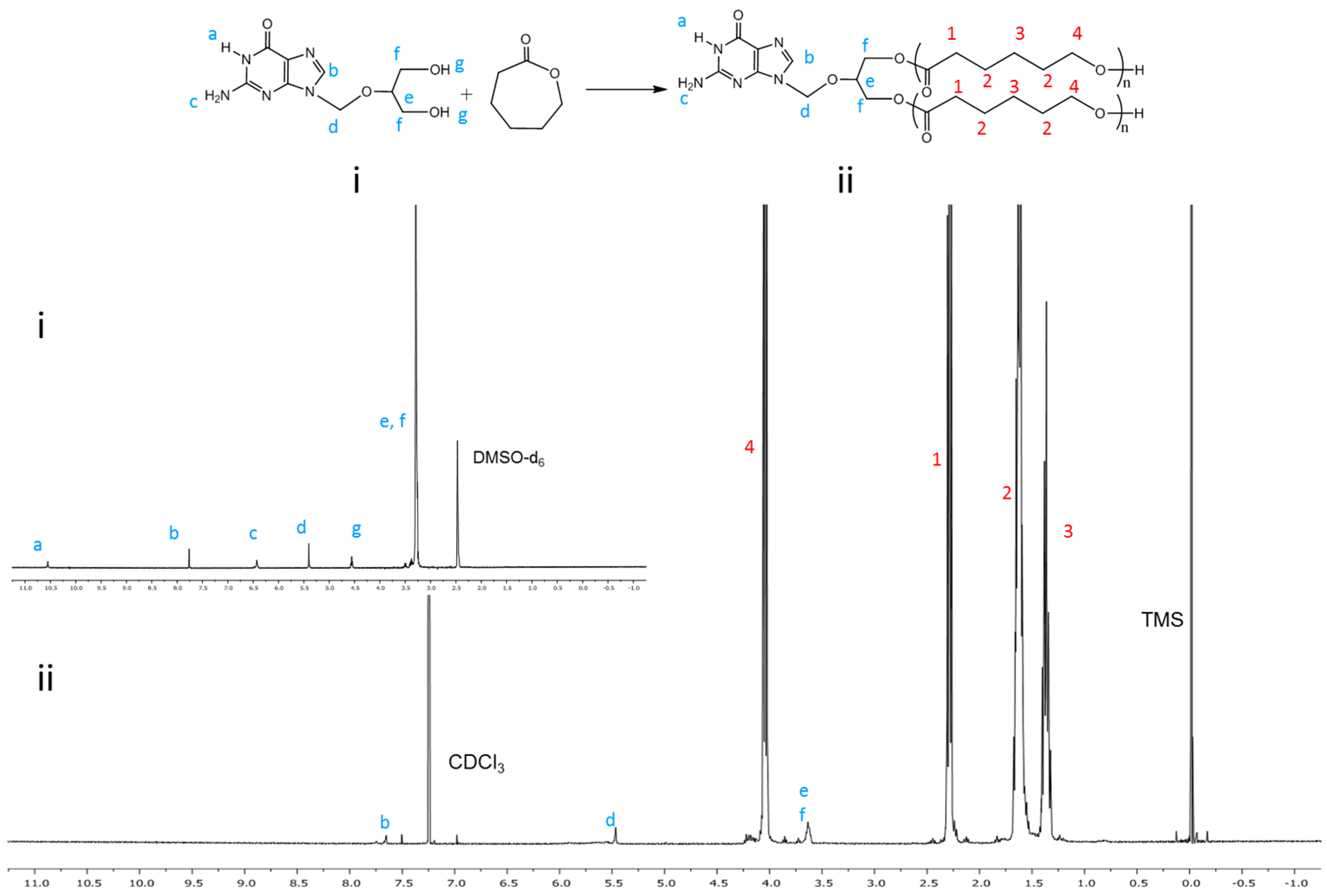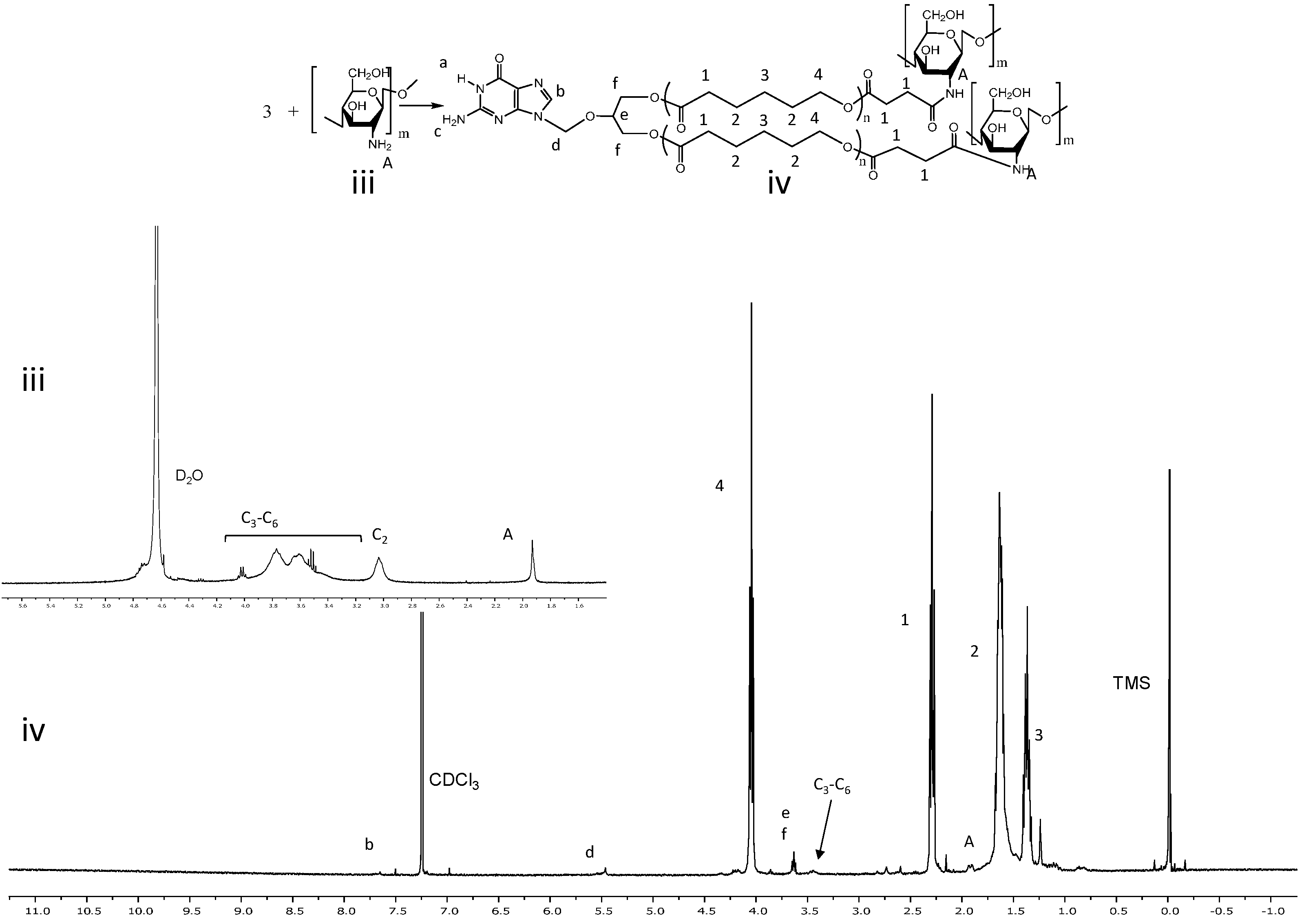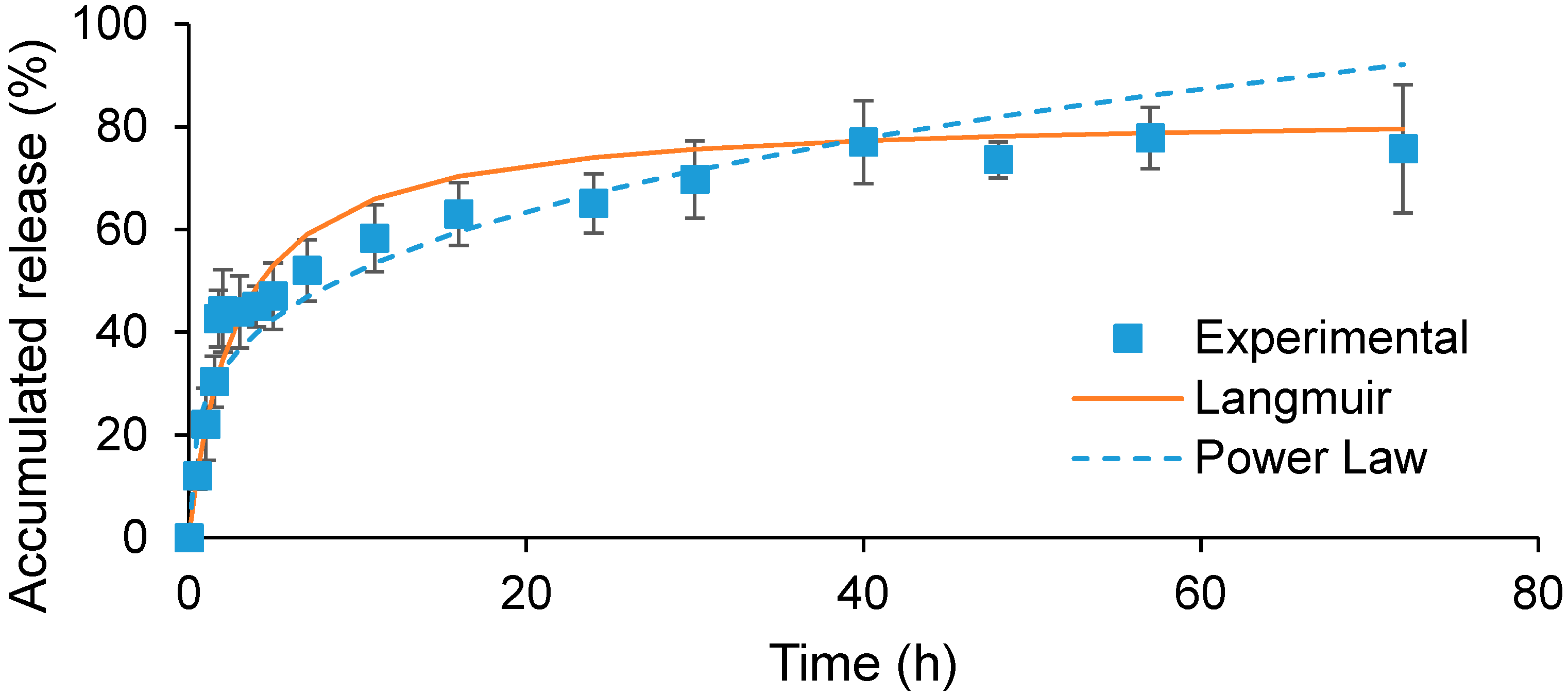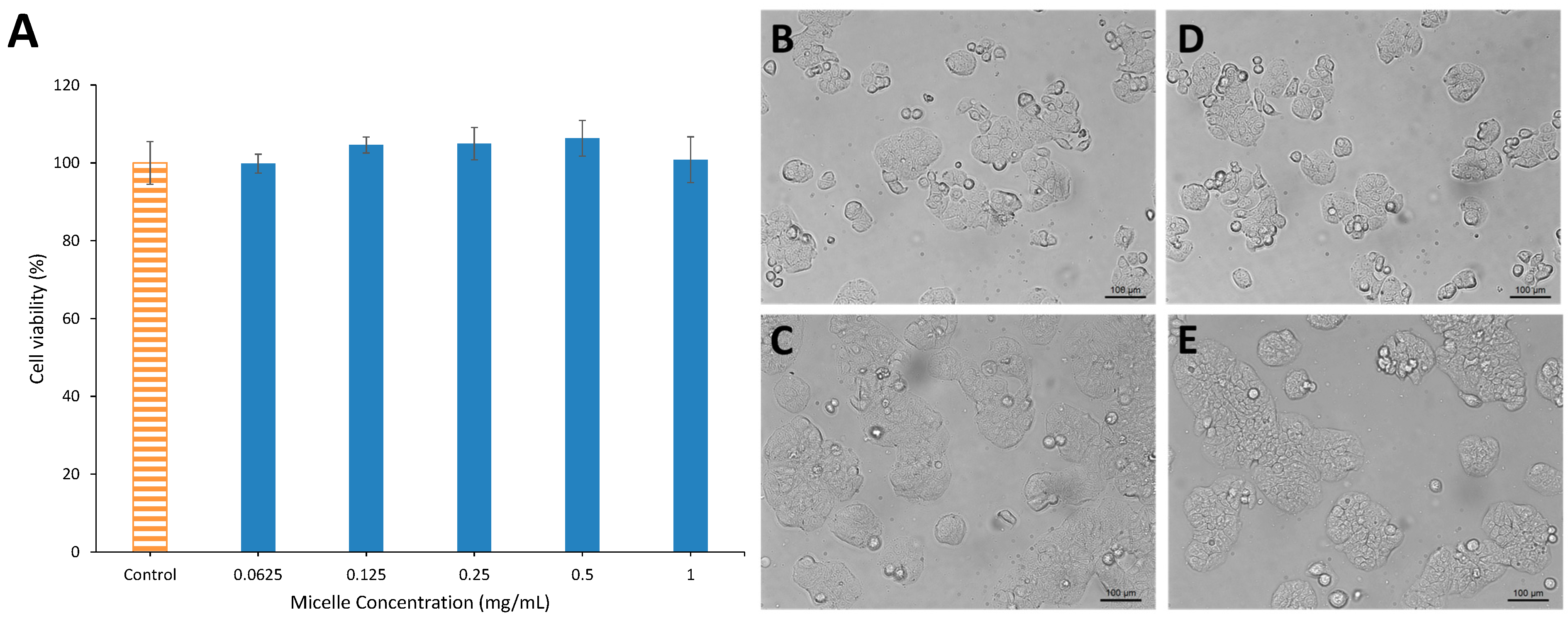Ring-Opening Polymerization of ε-Caprolactone Initiated by Ganciclovir (GCV) for the Preparation of GCV-Tagged Polymeric Micelles
Abstract
:1. Introduction
2. Results and Discussion
2.1. Synthesis and Characterization of Amphiphilic Prodrug Polymers




| Sample | Mw (Da) | Mn(obsd) a (Da) | Mn(corrected) b (Da) | Polydispersity (Mw/Mn(obsd)) |
|---|---|---|---|---|
| GCV-PCL | 12,996 | 11,454 | 6414 | 1.13 |
| GCV-PCL-chitosan | 20,354 | 17,231 | 9649 | 1.18 |
2.2. Formation and Characterization of GCV-Tagged Polymeric Micelles

2.3. In Vitro Release of GCV from Polymeric Micelles

2.4. Cytotoxicity Test

3. Experimental Section
3.1. Materials
3.2. Characterization Methods
3.3. Synthesis of GCV-Tagged Amphiphilic Polymers
3.4. Preparation of Polymeric Prodrug Micelles
3.5. Size and Charge of Polymeric Prodrug Micelles
3.6. Drug Release Kinetics
3.7. Cytotoxicity Test
4. Conclusions
Acknowledgments
Author Contributions
Conflicts of Interest
References
- Faulds, D.; Heel, R. Ganciclovir. Drugs 1990, 39, 597–638. [Google Scholar] [CrossRef] [PubMed]
- Heinemann, M.H. Staphylococcus epidermidis endophthalmitis complicating intravitreal antiviral therapy of cytomegalovirus retinitis. Arch. Ophthalmol. 1989, 107, 643–644. [Google Scholar] [CrossRef] [PubMed]
- Henry, K.; Cantrill, H.; Fletcher, C.; Chinnock, B.; Balfour, H., Jr. Use of intravitreal ganciclovir (dihydroxy propoxymethyl guanine) for cytomegalovirus retinitis in a patient with AIDS. Am. J. Ophthalmol. 1987, 103, 17–23. [Google Scholar] [CrossRef] [PubMed]
- Kuppermann, B.D.; Quiceno, J.I.; Aguilar, M.F.; Connor, J.D.; Capparelli, E.V.; Sherwood, C.H.; Freeman, W.R. Intravitreal ganciclovir concentration after intravenous administration in AIDS patients with cytomegalovirus retinitis: Implications for therapy. J. Infect. Dis. 1993, 168, 1506–1509. [Google Scholar] [CrossRef] [PubMed]
- Kajiwara, E.; Kawano, K.; Hattori, Y.; Fukushima, M.; Hayashi, K.; Maitani, Y. Long-circulating liposome-encapsulated ganciclovir enhances the efficacy of HSV-TK suicide gene therapy. J. Control. Release 2007, 120, 104–110. [Google Scholar] [CrossRef] [PubMed]
- Merodio, M.; Arnedo, A.; Renedo, M.J.; Irache, J.M. Ganciclovir-loaded albumin nanoparticles: Characterization and in vitro release properties. Eur. J. Pharm. Sci. 2001, 12, 251–259. [Google Scholar] [CrossRef] [PubMed]
- Chen, X.; Ooi, C.P. Hydrolytic degradation and drug release properties of ganciclovir-loaded biodegradable microspheres. Acta Biomater. 2008, 4, 1046–1056. [Google Scholar] [CrossRef] [PubMed]
- Akhter, S.; Kushwaha, S.; Warsi, M.H.; Anwar, M.; Ahmad, M.Z.; Ahmad, I.; Talegaonkar, S.; Khan, Z.I.; Khar, R.K.; Ahmad, F.J. Development and evaluation of nanosized niosomal dispersion for oral delivery of Ganciclovir. Drug Dev. Ind. Pharm. 2012, 38, 84–92. [Google Scholar] [CrossRef] [PubMed]
- Duvvuri, S.; Janoria, K.G.; Mitra, A.K. Development of a novel formulation containing poly(d,l-lactide-co-glycolide) microspheres dispersed in PLGA-PEG-PLGA gel for sustained delivery of ganciclovir. J. Control. Release 2005, 108, 282–293. [Google Scholar] [CrossRef] [PubMed]
- Kwon, G.S. Polymeric micelles for delivery of poorly water-soluble compounds. Crit. Rev. Ther. Drug Carrier Syst. 2003, 20, 357–403. [Google Scholar] [CrossRef] [PubMed]
- Del Amo, E.M.; Urtti, A. Current and future ophthalmic drug delivery systems: A shift to the posterior segment. Drug Discov. Today 2008, 13, 135–143. [Google Scholar]
- Nakanishi, T.; Fukushima, S.; Okamoto, K.; Suzuki, M.; Matsumura, Y.; Yokoyama, M.; Okano, T.; Sakurai, Y.; Kataoka, K. Development of the polymer micelle carrier system for doxorubicin. J. Control. Release 2001, 74, 295–302. [Google Scholar] [CrossRef] [PubMed]
- Hamaguchi, T.; Matsumura, Y.; Suzuki, M.; Shimizu, K.; Goda, R.; Nakamura, I.; Nakatomi, I.; Yokoyama, M.; Kataoka, K.; Kakizoe, T. NK105, a paclitaxel-incorporating micellar nanoparticle formulation, can extend in vivo antitumour activity and reduce the neurotoxicity of paclitaxel. Br. J. Cancer 2005, 92, 1240–1246. [Google Scholar] [CrossRef] [PubMed]
- Koizumi, F.; Kitagawa, M.; Negishi, T.; Onda, T.; Matsumoto, S.I.; Hamaguchi, T.; Matsumura, Y. Novel SN-38—Incorporating polymeric micelles, NK012, eradicate vascular endothelial growth factor—Secreting bulky tumors. Cancer Res. 2006, 66, 10048–10056. [Google Scholar] [CrossRef] [PubMed]
- Sinha, V.R.; Singla, A.K.; Wadhawan, S.; Kaushik, R.; Kumria, R.; Bansal, K.; Dhawan, S. Chitosan microspheres as a potential carrier for drugs. Int. J. Pharm. 2004, 274, 1–33. [Google Scholar] [CrossRef] [PubMed]
- Dash, T.K.; Konkimalla, V.B. Poly-ε-caprolactone based formulations for drug delivery and tissue engineering: A review. J. Control. Release 2012, 158, 15–33. [Google Scholar] [CrossRef] [PubMed]
- Peng, C.L.; Shieh, M.J.; Tsai, M.H.; Chang, C.C.; Lai, P.S. Self-assembled star-shaped chlorin-core poly(ɛ-caprolactone)-poly(ethylene glycol) diblock copolymer micelles for dual chemo-photodynamic therapies. Biomaterials 2008, 29, 3599–3608. [Google Scholar] [CrossRef] [PubMed]
- Schindler, A.; Hibionada, Y.M.; Pitt, C.G. Aliphatic polyesters. III. Molecular weight and molecular weight distribution in alcohol-initiated polymerizations of ϵ-caprolactone. J. Polym. Sci.: Polym. Chem. Ed. 1982, 20, 319–326. [Google Scholar] [CrossRef]
- Aliabadi, H.M.; Mahmud, A.; Sharifabadi, A.D.; Lavasanifar, A. Micelles of methoxy poly(ethylene oxide)-b-poly(ɛ-caprolactone) as vehicles for the solubilization and controlled delivery of cyclosporine A. J. Control. Release 2005, 104, 301–311. [Google Scholar] [CrossRef] [PubMed]
- Dubois, P.; Krishnan, M.; Narayan, R. Aliphatic polyester-grafted starch-like polysaccharides by ring-opening polymerization. Polymer 1999, 40, 3091–3100. [Google Scholar] [CrossRef]
- Sonia, T.; Sharma, C. Chitosan and its derivatives for drug delivery perspective. In Chitosan for Biomaterials I; Springer: Berlin/Heidelberg, Germany, 2011; pp. 23–53. [Google Scholar]
- Haddad, M.; Laghzaoui, M.; Welter, R.; Dagorne, S. Synthesis and structure of neutral and cationic aluminum complexes supported by bidentate O,P-phosphinophenolate ligands and their reactivity with propylene oxide and ε-caprolactone. Organometallics 2009, 28, 4584–4592. [Google Scholar] [CrossRef]
- Barakat, I.; Dubois, P.; Jérôme, R.; Teyssié, P. Macromolecular engineering of polylactones and polylactides. X. Selective end-functionalization of poly(d,l)-lactide. J. Polym. Sci. Part A: Polym. Chem. 1993, 31, 505–514. [Google Scholar] [CrossRef]
- Siepmann, J.; Siepmann, F. Mathematical modeling of drug delivery. Int. J. Pharm. 2008, 364, 328–343. [Google Scholar] [CrossRef] [PubMed]
- Sawdon, A.J.; Peng, C.A. Polymeric micelles for acyclovir drug delivery. Colloids Surf. B: Biointerfaces 2014, 122, 738–745. [Google Scholar] [CrossRef] [PubMed]
- Sample Availability: Samples of the compounds are available from the authors.
© 2015 by the authors. Licensee MDPI, Basel, Switzerland. This article is an open access article distributed under the terms and conditions of the Creative Commons Attribution license ( http://creativecommons.org/licenses/by/4.0/).
Share and Cite
Sawdon, A.J.; Peng, C.-A. Ring-Opening Polymerization of ε-Caprolactone Initiated by Ganciclovir (GCV) for the Preparation of GCV-Tagged Polymeric Micelles. Molecules 2015, 20, 2857-2867. https://doi.org/10.3390/molecules20022857
Sawdon AJ, Peng C-A. Ring-Opening Polymerization of ε-Caprolactone Initiated by Ganciclovir (GCV) for the Preparation of GCV-Tagged Polymeric Micelles. Molecules. 2015; 20(2):2857-2867. https://doi.org/10.3390/molecules20022857
Chicago/Turabian StyleSawdon, Alicia J., and Ching-An Peng. 2015. "Ring-Opening Polymerization of ε-Caprolactone Initiated by Ganciclovir (GCV) for the Preparation of GCV-Tagged Polymeric Micelles" Molecules 20, no. 2: 2857-2867. https://doi.org/10.3390/molecules20022857
APA StyleSawdon, A. J., & Peng, C.-A. (2015). Ring-Opening Polymerization of ε-Caprolactone Initiated by Ganciclovir (GCV) for the Preparation of GCV-Tagged Polymeric Micelles. Molecules, 20(2), 2857-2867. https://doi.org/10.3390/molecules20022857




